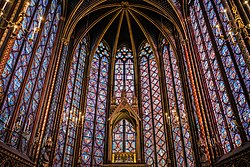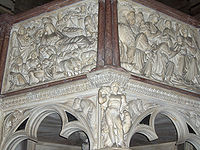Gothic art
Top: The Western (Royal) Portal of the Chartres Cathedral (circa 1145), these architectural statues being the earliest Gothic sculptures and a revolution in style and the model for a generation of sculptors; Centre: The Sainte-Chapelle from Paris (1194-1248); Bottom: The Wilton Diptych (1395–1459) | |
| Years active | Late 12th century-16th century |
|---|---|
Gothic art was a style of medieval art that developed in Northern France out of Romanesque art in the 12th century AD, led by the concurrent development of Gothic architecture. It spread to all of Western Europe, and much of Northern, Southern and Central Europe, never quite effacing more classical styles in Italy. In the late 14th century, the sophisticated court style of International Gothic developed, which continued to evolve until the late 15th century. In many areas, especially Germany, Late Gothic art continued well into the 16th century, before being subsumed into Renaissance art. Primary media in the Gothic period included sculpture, panel painting, stained glass, fresco and illuminated manuscripts. The easily recognizable shifts in architecture from Romanesque to Gothic, and Gothic to Renaissance styles, are typically used to define the periods in art in all media, although in many ways figurative art developed at a different pace.
The earliest Gothic art was
Origins
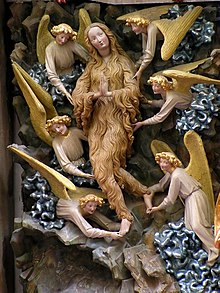
Gothic art emerged in
Although there was far more secular Gothic art than is often thought today, as generally the survival rate of religious art has been better than for secular equivalents, a large proportion of the art produced in the period was religious, whether commissioned by the church or by the laity. Gothic art was often
Iconography was affected by changes in theology, with depictions of the
Etymology
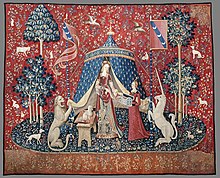
The word "
would famously comment on Gothic:The besotted taste of Gothic monuments,
These odious monsters of ignorant centuries,
Which the torrents of barbary spewed forth.[5]
In its beginning, Gothic art was initially called "French work" (Opus Francigenum), thus attesting the priority of France in the creation of this style.[5]
Painting
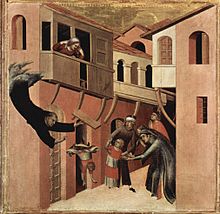
Painting in the Gothic style did not exist until around 1200, over 50 years after the beginnings of Gothic architecture and sculpture. The transition from Romanesque to Gothic is very imprecise and not at all a clear break, and Gothic ornamental detailing is often introduced before much change is seen in the style of figures or compositions themselves. Then figures become more animated in pose and facial expression, tend to be smaller in relation to the background of scenes, and are arranged more freely in the pictorial space, where there is room. This transition occurs first in England and France around 1200, in Germany around 1220 and Italy around 1300. Painting during the Gothic period was practiced in four primary media:
Frescos
Frescos continued to be used as the main pictorial narrative craft on church walls in southern Europe as a continuation of early Christian and Romanesque traditions. An accident of survival
Stained glass

In northern Europe, stained glass was an important and prestigious form of painting until the 15th century, when it became supplanted by panel painting. Gothic architecture greatly increased the amount of glass in large buildings, partly to allow for wide expanses of glass, as in rose windows. In the early part of the period mainly black paint and clear or brightly coloured glass was used, but in the early 14th century the use of compounds of silver, painted on glass which was then fired, allowed a number of variations of colour, centred on yellows, to be used with clear glass in a single piece. By the end of the period designs increasingly used large pieces of glass which were painted, with yellows as the dominant colours, and relatively few smaller pieces of glass in other colours.[10]
Manuscripts and printmaking

Illuminated manuscripts represent the most complete record of Gothic painting, providing a record of styles in places where no monumental works have otherwise survived. The earliest full manuscripts with French Gothic illustrations date to the middle of the 13th century.[11] Many such illuminated manuscripts were royal bibles, although psalters also included illustrations; the Parisian Psalter of Saint Louis, dating from 1253 to 1270, features 78 full-page illuminations in tempera paint and gold leaf.[12]
During the late 13th century, scribes began to create prayer books for the laity, often known as
From the middle of the 14th century,
Altarpiece and panel painting
Painting with oil on canvas did not become popular until the 15th and 16th centuries and was a hallmark of Renaissance art. In Northern Europe the important and innovative school of Early Netherlandish painting is in an essentially Gothic style, but can also be regarded as part of the Northern Renaissance, as there was a long delay before the Italian revival of interest in classicism had a great impact in the north. Painters like Robert Campin and Jan van Eyck made use of the technique of oil painting to create minutely detailed works, correct in perspective, where apparent realism was combined with richly complex symbolism arising precisely from the realistic detail they could now include, even in small works. In Early Netherlandish painting, from the richest cities of Northern Europe, a new minute realism in oil painting was combined with subtle and complex theological allusions, expressed precisely through the highly detailed settings of religious scenes. The Mérode Altarpiece (1420s) of Robert Campin and the Washington Van Eyck Annunciation or Madonna of Chancellor Rolin (both 1430s, by Jan van Eyck) are examples.[14] For the wealthy, small panel paintings, even polyptychs in oil painting were becoming increasingly popular, often showing donor portraits alongside, though often much smaller than the Virgin or saints depicted. These were usually displayed in the home.
Sculpture
Monumental sculpture
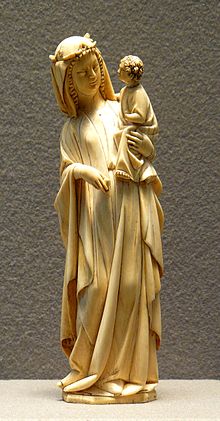
The Gothic period is essentially defined by Gothic architecture, and does not entirely fit with the development of style in sculpture in either its start or finish. The facades of large churches, especially around doors, continued to have large tympanums, but also rows of sculpted figures spreading around them.
The statues on the Western (Royal) Portal at
"In Italy the Gospel of Gothic was preached from pulpits not from tympana, and the unit of the sculptor's thinking was an autonomous, self-consistent work of art" (John Pope-Hennessy).[16]
Another revival of classical style is seen in the
Life-size tomb effigies in stone or alabaster became popular for the wealthy, and grand multi-level tombs evolved, with the Scaliger Tombs of Verona so large they had to be moved outside the church. By the 15th century there was an industry exporting Nottingham alabaster altar reliefs in groups of panels over much of Europe for economical parishes who could not afford stone retables.[20]
-
South portal of Chartres Cathedral (c. 1215–20).
-
West portal at Reims Cathedral, Annunciation group.
-
David and a prophet from the Well of Moses.
-
Base of the Holy Thorn Reliquary, French (Paris), 1390s, a Resurrection of the Dead in gold, enamel and gems.
-
Ulm Münster by Hans Multscher, 1429.
-
Panelled altarpiece section withResurrection of Christ, English Nottingham alabaster, 1450–90, with remains of colour.
-
Later Gothic depiction of the Adoration of the Magi from Strasbourg Cathedral.
-
Detail of thelimewood, Rothenburg ob der Tauber, Bavaria.
Portable sculpture

Small carvings, for a mainly lay and often female market, became a considerable industry in Paris and some other centres. Types of ivories included small, devotional

Gothic sculptures independent of architectural ornament were primarily created as devotional objects for the home or intended as donations for local churches,[23] although small reliefs in ivory, bone and wood cover both religious and secular subjects, and were for church and domestic use. These sculptures were created by urban artisans, and the most common theme for three-dimensional small statues is the Virgin Mary alone or with a child.[24] Paris was the main centre of ivory workshops, and exported to most of northern Europe, though Italy also had a considerable production. An exemplar of these independent sculptures is among the collections of the Abbey Church of St Denis; the silver-gilt Virgin and Child dates to 1339 and features Mary enveloped in a flowing cloak holding an infantile Christ figure.[24] Both the simplicity of the cloak and the youth of the child presage other sculptures found in northern Europe dating to the 14th century and early 15th century.[24] Such sculpture shows an evolution from an earlier stiff and elongated style, still partly Romanesque, into a spatial and naturalistic feel in the late 12th and early 13th century.[24] Other French Gothic sculptural subjects included figures and scenes from popular literature of the time.[24] Imagery from the poetry of the troubadours was particularly popular among artisans of mirror-cases and small boxes presumably for use by women.[24] The Casket with Scenes of Romances (Walters 71264) of 1330–50 is an unusually large example with space for a number of scenes from different literary sources.
Souvenirs of pilgrimages to shrines, such as clay or lead
See also
- Blackletter (also known as Gothic script)
- Church frescos in Denmark
- Church frescos in Sweden
- Danse Macabre
- Gothic cathedrals and churches
- History of painting
- List of Gothic artists
- Pleurants
- Renaissance of the 12th century
- The Ten Virgins
- Timeline of Italian artists to 1800
- Western painting
Notes
- ^ Stokstad (2005), 516.
- ^ Stokstad (2005), 544.
- ^ Émile Mâle, The Gothic Image, Religious Art in France of the Thirteenth Century, pp. 165–8, English trans of 3rd edn, 1913, Collins, London (and many other editions) is a classic work on French Gothic church art
- ^ "Gothic art". Encyclopedia Britannica. Retrieved 22 June 2017.
- ^ ISBN 978-0-7386-6996-0.
- ^ E. S. de Beer, Gothic: Origin and Diffusion of the Term; The Idea of Style in Architecture in Journal of the Warburg and Courtauld Institutes, Vol.11, 1948, pp. 143–62
- ISBN 978-0-486-20717-9.
- ^ The art of the sublime: principles of Christian art and architecture by Roger Homan p. 70 [1]
- ^ Kirsten Trampedach: Introduction to Danish Wall Paintings – Conservation Ethics and Methods of Treatment. National Museum of Denmark Archived 24 November 2009 at the Wayback Machine. Retrieved 6 September 2009.
- ^ Coe, 8–11
- ^ Stokstad (2005), 540.
- ^ a b c d Stokstad (2005), 541.
- ^ Stokstad (2005), 542.
- ISBN 0-06-430133-8analyses all these works in detail. See also the references in the articles on the works.
- ^ Honour and Fleming, 297–300; Henderson, 55, 82–84
- ^ Pope-Hennessy, 11
- ^ Olson, 11–24; Honour and Fleming, 304; Henderson, 41
- ^ Snyder, 65–69
- ^ Snyder, 305–311
- V&A Museumfeature on the Nottingham alabaster Swansea Altarpiece
- ^ Calkins, 193–198
- ^ Cherry, 25–48; Henderson, 134–141
- ^ Stokstad (2005), 537.
- ^ a b c d e f Stokstad (2005), 539.
- ^ Cherry (2003), 204
References
- Calkins, Robert G.; Monuments of Medieval Art, Dutton, 1979, ISBN 0525475613
- Cherry, John. The Holy Thorn Reliquary, 2010, British Museum Press (British Museum objects in focus), ISBN 0-7141-2820-1
- Cherry, John, in Marks, Richard and Williamson, Paul, eds. Gothic: Art for England 1400–1547, 2003, V&A Publications, London, ISBN 1-85177-401-7
- Focillon, Henri (1980). The Art of the West in the Middle Ages: Vol. 2 - Gothic. Ithaca, NY: Cornell University Press. ISBN 978-0801491924.
- Henderson, George. Gothic, 1967, Penguin, ISBN 0-14-020806-2
- ISBN 0333371852
- Olson, Roberta J.M., Italian Renaissance Sculpture, 1992, Thames & Hudson (World of Art), ISBN 978-0-500-20253-1
- Pope-Hennessy, John, Introduction to Italian Sculpture, Volume 1, Italian Gothic Sculpture, 1955, Fourth Edition 1996, Phaidon Press, ISBN 0-7148-3014-3
- Robinson, James, Masterpieces of Medieval Art, 2008, British Museum Press, ISBN 978-0-7141-2815-3
- ISBN 978-1405198783
- Rudolph, Conrad, "Inventing the Gothic Portal: Suger, Hugh of Saint Victor, and the Construction of a New Public Art at Saint-Denis," Art History 33 (2010) 568–595
- Rudolph, Conrad, "Inventing the Exegetical Stained-Glass Window: Suger, Hugh, and a New Elite Art," Art Bulletin 93 (2011) 399–422
- ISBN 0136235964
External links
- Gothic art, from ArtCyclopedia.com
- Gothic art, from Encyclopædia Britannica Online.
- Gothic art (Archived 2009-10-31), from Microsoft Encarta.
- Gothic art Archived 5 March 2005 at the The Columbia Encyclopedia, Sixth Edition. 2001.
- Gothic art, Museumsportal Schleswig-Holstein
- Gothic art, from "A World History of Art" and [3].
- "Gothic: Art for England 1400–1547". Victoria and Albert Museum. Retrieved 8 June 2007.
- The Pietà in French late Gothic sculpture: regional variations, a book from The Metropolitan Museum of Art Libraries (fully available online as PDF), which contains material on Gothic art


